Subtleties of obtaining permission to connect to a gas pipeline - the legislative side of the issue
Gas connection is one of the most important moments in arranging your own home.But in order to rekindle your family hearth, you first need to obtain permission to connect to the gas pipeline, which is not so easy to do.
What is primary subscriber consent? What to do if you want to do it cheaper, but it turns out either expensive or through someone else’s site? Who should you ask if you are drawing gas from the main line? Future owners always have a lot of questions at the initial stages of the process, but we will try to answer them in as much detail as possible.
The content of the article:
What facilities are allowed to be gasified?
Before you start fussing about supplying gas to the facility, find out whether it can be done.
Gasify according to Federal Law No. 69 you can: private houses, as well as apartment buildings, put into operation; areas with buildings that have not yet been put into operation, at the stage of completing their design; country houses and garden houses in the presence of capital buildings (foundation); organizations.
At your local gas distribution center you can find out whether and under what conditions it is possible to connect your building to the gas supply.
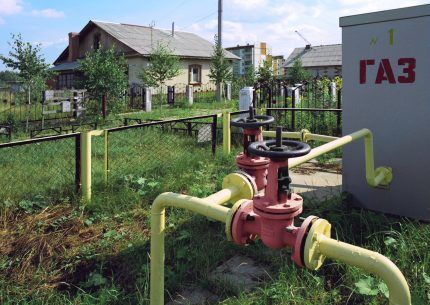
Based RF PP No. 549, it is impossible to connect to the gas supply network:
- non-permanent buildings that do not have a foundation, that is, garages, summer kitchens, greenhouses, and so on;
- some apartments in an apartment building, provided there is no gas in the entire building;
- country houses and garden houses without a permanent foundation and registration in the Unified State Register of Real Estate.
If you have found your object in the top list, congratulations, you can start the process of preparing and collecting documents.
Initial stage of gasification
So, in order to connect a house to the gas supply system, you must first determine whether there are technical capabilities for this and obtain all the necessary permits.
If you do not know who supervises the local pipe networks, contact your local government or ask your gas-connected neighbors, if any.
Next, you need to submit a request to the GRO, preferably in person, whether there is any available gas in your area and who is the owner of the nearest gas pipeline and how best to connect to it. If you connect to the main pipeline, coordination with the gas distribution organization is required, but it is possible that the gas pipeline network must have a different owner. This could be a local municipality, a private person, a legal entity, or SNT.
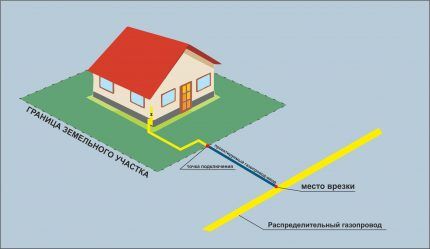
The division is something like this:
- Transportation lines and compressor stations, as well as gas branches to populated areas are owned by the gas company.
- Pipelines running along the streets of a populated area may belong to a gas distribution organization, a local municipality, organizations, a collective meeting of owners, or a private individual.
- The gas branch on the owner's land plot from the point of insertion into the distribution main to the connection to gas consuming devices is the property of the owner of the land plot or his legal successor.
Thus, having identified the owner and clarified with the State Distribution Department the possibility of connecting according to the load, the next step will be to issue a permit for the connection.
If you are not the owner of the gas pipeline to which you are connecting, you need to obtain permission from a neighbor or municipality to carry gas, if they own the branch. Permitting is a primary and necessary part of the process of starting a process connection. This commitment is recorded in Part 2 RF PP No. 1314, in paragraph 8, which contains a list of documents provided for obtaining technical specifications.
According to it, the consent of the main subscriber is required for technological connection to pipes under his control and ownership, even if he himself does not use this natural resource.
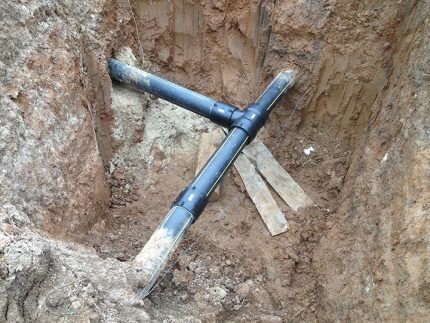
Also, according to the same rules, clause 34 states that the consent of the main subscriber is necessary when drawing up technical conditions and submitting an application for connection. At the same time, if a gas pipe passes through someone else’s property, then it is also necessary to carry out the construction of a branch on its territory.
And if there should be no problems with the local municipality, as well as with SNT, which do not have the right to give a refusal according to the same rules, then with private owners there are often difficulties in coordination.
Let's take a closer look at this point.
The main subscriber is a private person
Article 209 of the Civil Code of the Russian Federation states that the rights to use property belong to its owner, according to article 210 the owner bears the burden of responsibility for his property. And according to the article 304 Civil Code of the Russian Federation, if the property was used without the owner’s knowledge, he has the right to demand that all violations be eliminated.
You should first clarify whether the pipe officially and legally belongs to a specific subscriber. It often happens that a gas pipeline (that does not go through the site) was laid at the expense of a legal entity or individual, but ownership was not registered and is entirely on the balance sheet of the gas service or municipality.
If the gas pipe to which you plan to connect is owned by an individual, organization, partnership or legal entity, you must obtain their written consent.
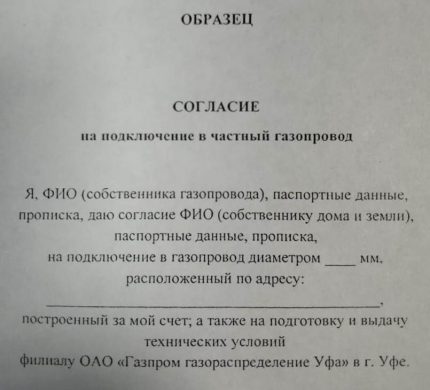
You don’t have to look for how such a document is filled out; the main subscriber’s consent to connect the gas is not written according to the established template, although the content is approximately the same.
In addition, it is recommended to issue a notarized receipt, if possible.
The general information of the permit document contains personal data of the pipeline owner - full name, exact address of residence and location of the object of approval, signature, date of signing the contract.
Very often, the owner of the pipeline demands compensation for the tie-in, the amount of which is negotiable and not established by law. If you have made full or partial payment, this fact must be documented by taking a receipt.
Also, if the pipe is located at a neighbor’s place or it is closer and more convenient to drag it through, it is also necessary to obtain consent to lay a gas pipeline along his section, and in addition, stipulate the possibility of reconstructing communications, inspecting and repairing them.

If we are talking about the main subscriber as a collective community, the same procedure applies, but property is regulated Art. 246 and 247 Civil Code of the Russian Federation, which indicate that it is possible to own and use common property by agreement of all owners. If agreement is not reached, the decision can be appealed in court.
Primary subscriber permissions
Unfortunately, the owner's consent to gas pipeline tie-in not always enough. The fact is that the official owner could change during the use of the gas pipeline, which means that the new owner, who has not re-registered the gas pipeline, does not have the right to issue permits.
To restore or re-register ownership rights to an object, it is necessary for a person to contact the State Registration Office with the following documents:
- a statement written in the form;
- a copy of the title deed or any other document confirming his ownership of the property;
- a power of attorney, if the re-registration is carried out by a person authorized by the applicant;
- Specifications for the technological connection of your facility to gas supply networks;
- a copy of project documents;
- a copy of the contract with the supplier.
Or other documents that somehow confirm the fact of registration of connection to networks, if there is no act of connection.
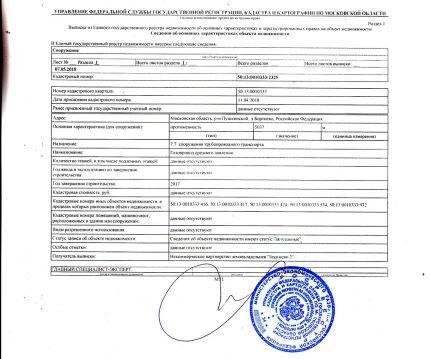
The complete list must be clarified with the organization. And only after this can you begin to draw up an agreement.
Connection with power concession
According to PP No. 1314A person, natural or legal, who has owned a gas branch for at least 5 years, can enter into an agreement with the owner of the branch to connect to his pipes with a concession of power. Of course, if there is such a technical possibility.
Such an agreement is relevant if the gas pipeline load is not enough for your facility along the main line.
The technical feasibility is determined by the connection executor, that is, the GRO, but subject to the following conditions:
- Upon reaching an agreement with the main consumer. This is called an assignment agreement.
- If both parties have received technical conditions confirming this possibility.
- In the case where such a connection is possible.
When drawing up this type of agreement, both consumers, present and future, send a request to the contractor.
This document should contain information such as:
- Full name of the assigning owner or the name of his organization;
- the exact address of the gas-duct branch;
- volume of power transferred;
- connection points;
- Full name of the new consumer or name of the organization.
The contractor makes a decision within 22 days from the date of receipt of the application, in writing, and this service is provided free of charge.

However, there are also limitations. For example, a current consumer must replace all of his gas equipment with a less powerful one, taking into account the gas consumption of the new consumer, and it is also necessary to make all the necessary changes to the design documentation.
Thus, this option should also be considered when connecting to a gas pipeline, if there is no other option.
Obtaining permission from the administration
Coordination with the municipality is a simpler issue. The State Services portal states that it can be issued in person, through a representative or by mail and it is absolutely free.
To apply, you must submit the following package of documents:
- An application filled out according to the standard form. Here's an example Sample application.
- Copies gas supply project.
- Certificates of ownership, use or lease of an object in the form of copies.
- Identity documents for individuals.
- Power of attorney, if the agreement is not ordered by the owner of the property.
- For legal entities, copies of organization documents and the right to represent the interests of the company.
The grounds for refusal may be incorrectly executed documents or incomplete provision of them, as well as other reasons, which representatives of the municipality will necessarily indicate in writing. The refusal may be appealed.

By the way, a request for permission to tap into a gas pipeline carried out according to the model that is on the portal.
You can find out more about the procedure on the State Services portal, at the MFC or at the administration of your region.
Conclusions and useful video on the topic
Positive experience of a dispute with the owner of a gas pipeline:
Thus, obtaining a permit for gasification is quite simple through the administration or after obtaining the consent of the main subscriber. The main thing is to collect all the necessary documents and correctly carry out the necessary approvals.
Have you had experience coordinating a gas pipeline connection with the main subscriber? Or maybe you have questions about the topic of the article? Share your stories, leave questions and participate in the discussion of the material in the block below.




Good evening. Please tell me, is there a statute of limitations for the consent of the main subscriber? How long should the tie-in take place?
The fact is that the developer of our apartment building gave consent to a private cottage located not far from us to tie into the gas pipeline, which was being built for 3 five-story buildings.
He didn’t hand over the gas pipeline to us or the GRO; he died.
The chairman of TSN went to conclude a VDGO agreement, and the State Regional Development Office issued documents stating that the technical conditions were obtained by the developer only for our one house, and the entire 2 km pipe was ours. Now the owner of the cottage comes, has laid out his pipe and wants to crash, do we have the right to prevent the private owner from crashing?